Golden Nuggets… yet another “find”…
May 25, 2015 by GuyHeilenman · Leave a Comment
At Rare & Early Newspapers we always enjoy hearing about the various “finds” that permeate the collectible. While most significant content is know before one purchases an issue to add to their collection, due to the nature of the hobby, golden nuggets cannot help but be buried, yet  undiscovered, deep within the pages of a newspaper. In some instances, the discoveries are quite significant – that is, significant to all having a general knowledge of history. In other cases, the find might be a little more subtle – yet still worthy of bringing to light.
undiscovered, deep within the pages of a newspaper. In some instances, the discoveries are quite significant – that is, significant to all having a general knowledge of history. In other cases, the find might be a little more subtle – yet still worthy of bringing to light.
The following account was sent to us a few weeks back. Feel free to send along your own stories as well (send to guy@rarenewspapers.com).
You mentioned you like to hear about “finds”, in a group of 100 cheap
newspapers I bought from you folks probably many years ago I found a find. I have started to place my collection into all the same mylar holders and cataloging it into my computer one by one. [It was during this time] I came across a New York Tribune from August 12th, 1865 that was included in one of those $199 for 100 newspaper lots I purchased from you. The front page has a couple of interesting articles like the “Annexation” of Canada, which led up to their confederation in 1867. The most interesting was the hours old accounts of the Steamship Pewabic which collided with the Steamship Meteor on Lake Huron. As I recall I think it was either a National Geographic or Discovery channel show. When they discovered the ship that sank in 1865 it was perfectly preserved even the woodwork with the cold non salt waters of the Great Lakes.
It would have been better in a Detroit paper, but for $2, I certainly will not complain. I have probably purchased over a thousand newspapers and it took me this long to discover a neat find – maybe not great, but I am pleased. I probably purchased this lot in the mid to late 1990’s. Looking at your website, especially the warehouse photos, there is just too much material to read everything even with a good size staff.
Thanks T.C. for sharing your story with the Rare & Early Newspapers’ Family.
They put it in print… The floating soap surfaces…
April 27, 2015 by TimHughes · Leave a Comment
It’s interesting to find articles reporting the very beginning of some of the more commonplace items in present-day life, but which were given little consequence at the time. A good example is a rather inconspicuous article in an April 1, 1882 issue of “Scientific American“.
 Titled simply “Floating Soap”, the article includes: “…the peculiarity of the soap they were using. When one of the men had soaped himself he would drop the soap into the water and it would ‘bob up serenely from below’ like a cork, ready for the next man to pick it up…The soap was called ‘ivory’, presumably on account of being of a creamy white color like ivory…We are pleased to note that Messrs. Proctor and Gamble, of Cincinnati, have at last discovered how to make a soap that will float & at the same time be durable & serviceable, & reasonably cheap.”
Titled simply “Floating Soap”, the article includes: “…the peculiarity of the soap they were using. When one of the men had soaped himself he would drop the soap into the water and it would ‘bob up serenely from below’ like a cork, ready for the next man to pick it up…The soap was called ‘ivory’, presumably on account of being of a creamy white color like ivory…We are pleased to note that Messrs. Proctor and Gamble, of Cincinnati, have at last discovered how to make a soap that will float & at the same time be durable & serviceable, & reasonably cheap.”
Ivory soap remains today–some 133 years later–a very common product on store shelves around the world. And it still floats.
The Traveler… peace…
February 16, 2015 by The Traveler · 2 Comments
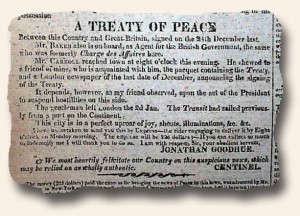 Today I traveled to Boston by the means of the Columbian Centinel dated February 5, 1815. There I found the breaking news of the “A TREATY OF PEACE between this Country and Great Britain, signed on the 24th December last… I have undertaken to send you this by Express — the rider engaging to deliver it by Eight o’clock on Monday morning… I am with respect, Sir, your obedient servant, JONATHAN GOODHUE.”
Today I traveled to Boston by the means of the Columbian Centinel dated February 5, 1815. There I found the breaking news of the “A TREATY OF PEACE between this Country and Great Britain, signed on the 24th December last… I have undertaken to send you this by Express — the rider engaging to deliver it by Eight o’clock on Monday morning… I am with respect, Sir, your obedient servant, JONATHAN GOODHUE.”
This peace treaty ended the War of 1812 between the United States and Great Britain and Ireland. Due to lack of telecommunications and time travels at that time, even though the treaty was signed December 24, 1814, the Battle of New Orleans was fought and won on January 8, 1815 and the Treaty was not in effect until it was ratified by the U.S. Senate on February 18, 1815.
~The Traveler
They put it in print…
January 26, 2015 by TimHughes · Leave a Comment
It was such a tragedy to America when Alexander Hamilton, the founding father of the United States, chief of staff to Washington in the Revolutionary War, and America’s first Secretary of the Treasury, was killed in a duel, an event he opposed but honor forced him to participate. His words from shortly before the duel are telling: ““My religion and moral principles are strongly opposed to the practice of dueling…My wife & children are extremely dear to me…I am conscious of no ill will to Col. Burr distinct from political opposition…But it was, as I conceive, impossible for me to avoid it…”. The report is found in the “Middlesex Gazette” newspaper of July 20, 1804 (see below).
His wounds at the hand of Aaron Burr–who curiously was Vice President at the time–would prove fatal. His comments give evidence to the value of honor among the early patriots, even when they lead to a tragic end.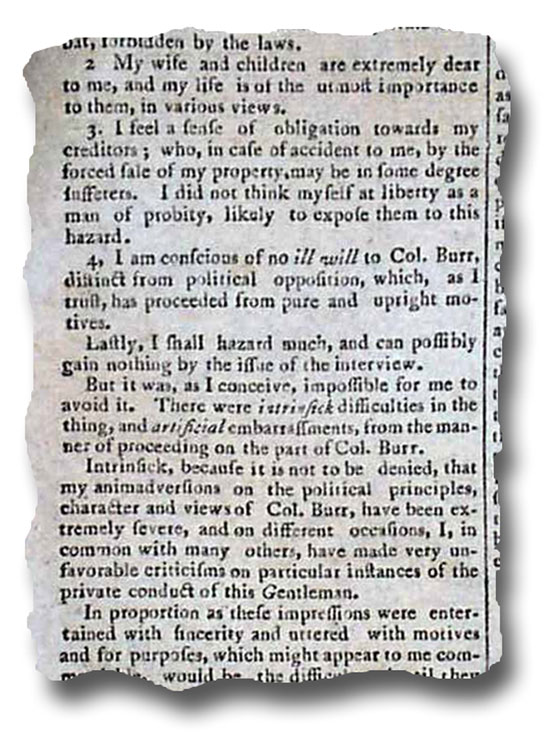
The times they are a-changin’… 19th century mixed-racial marriages
October 3, 2014 by GuyHeilenman · Leave a Comment
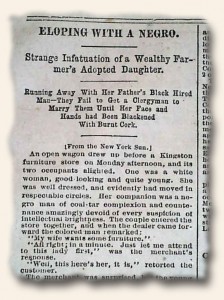 While progress in regards to interracial relations has been both painful and agonizingly slow an 1880’s issue of the St. Louis Globe-Democrat (November 15, 1880) provides a great opportunity for us to see just how far we have come in the last 100 years or so. Sometimes a 1,000 foot view provides a degree of encouragement where a close-up view only draws our attention to the blemishes. Yes, while slow, the times they are in fact a-changin’.
While progress in regards to interracial relations has been both painful and agonizingly slow an 1880’s issue of the St. Louis Globe-Democrat (November 15, 1880) provides a great opportunity for us to see just how far we have come in the last 100 years or so. Sometimes a 1,000 foot view provides a degree of encouragement where a close-up view only draws our attention to the blemishes. Yes, while slow, the times they are in fact a-changin’.
Government in action… yet another proud moment…
September 19, 2014 by GuyHeilenman · Leave a Comment
At first blush, this issue appears to be exactly what one might expect from a Government sponsored publication. However, upon closer inspection of the lower right corner, we soon realize… this is exactly what one might expect from a government sponsored publication. Somewhere, Julius and Ethel Rosenberg are smiling. Please enjoy the cover of the April, 1944 issue of the U.S. Army-Navy Journal: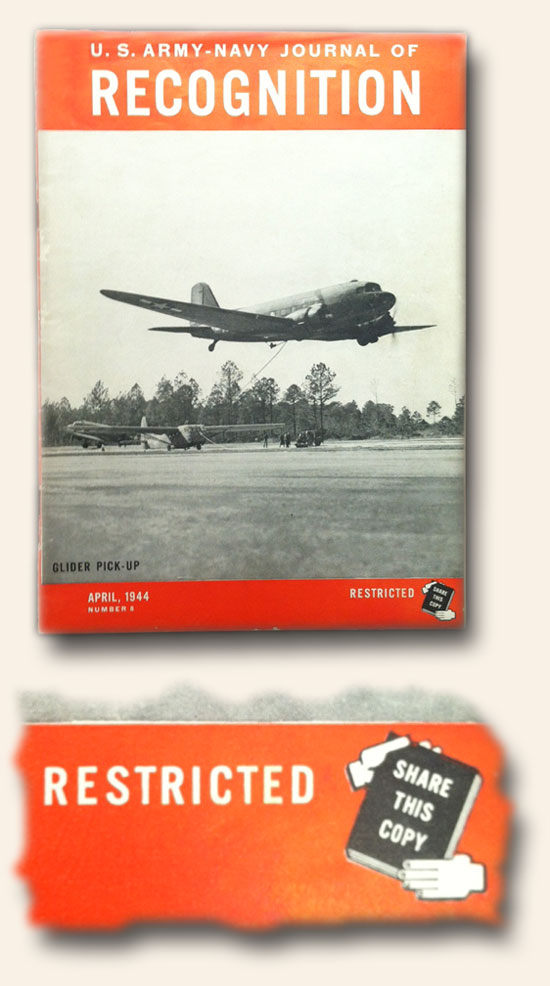
Dog – a man’s best friend?
August 15, 2014 by GuyHeilenman · Leave a Comment
We recently came across a National Intelligencer from November 16, 1848 which had a great story depicting the incredible relationship these wonderful creatures can have with humans. While they are traditionally known as being man’s best friend, their affinity for people apparently is not restricted as such. Please enjoy:
A gem from the American Antiquarian Society…
August 11, 2014 by TimHughes · Leave a Comment
In celebration of its 20oth anniversary the American Antiquarian Society published a beautiful exhibition catalog titled “In Pursuit Of A Vision – Two Centuries of Collecting at the American Antiquarian Society”. Featured are a fascinating array of books, documents, maps & other paper ephemera, as well as several very rare & unusual newspapers we felt worthy of sharing with our collectors (with permission from the A.A.S.).
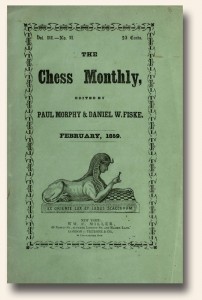 172. “The Chess Monthly“, New York, February, 1859
172. “The Chess Monthly“, New York, February, 1859
It has been common practice when binding periodicals — whether by publishers in order to sell cumulative volumes, or by libraries and private owners for purposes of convenience and preservation — to remove the outer wrappers and advertisement leaves from individual issues, leaving only the main body of text. However, periodical wrappers and advertisement leaves often contain important material which scholars (and bibliographers) are increasingly finding vital to their research. In recent years AAS has made it a priority to collect early American periodical issues with wrappers intact, even going so far as to acquire second, wrappered copies to complement a set bound without wrappers. In many instances, wrappered copies prove to be exceptionally rare survivals.
This issue of The Chess Monthly is a good example. The journal’s editor was Daniel W. Fiske (1831-1904), then chess champion of the New York Chess Club and later Cornell University’s first librarian. For a time, American chess prodigy and unofficial world champion Paul Morphy (1837-1884) held the title of co-editor, lending the magazine his marquee name. Only on the wrappers, however, are their editorial roles mentioned. The wrappers also contain publication information not available elsewhere, an advertisement for a set of Morphy- endorsed chessmen made of cast iron and — perhaps most important of all — the answers to chess problems published in the previous issue.
Where this governor ranks in the day’s news…
January 31, 2014 by TimHughes · Leave a Comment
“The Merrick County Item” newspaper of Central City, Nebraska, has a very inconspicuous & brief page 2 report in its December 1, 1880 issue announcing, almost casually, “Gov. Robinson, of Colorado, was on last Monday morning accidentally shot and killed.” This placement did rank above: “The National Grange will again convene in Washington, Nov. 1, 1881.” but below: “Trickett beat Ross in the sculling match on the Thames, last Monday, by about four lengths.” (see below)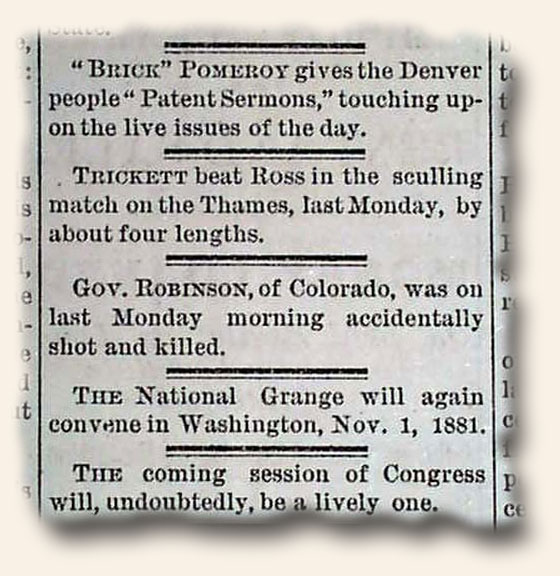
Gentleman’s Magazine: a little gem packed with history…
December 27, 2013 by TimHughes · Leave a Comment
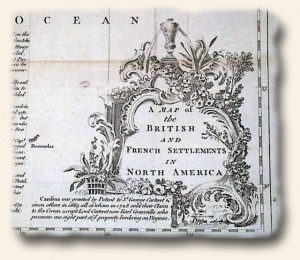
As dealers we have been very true to our focus on rare newspapers, and—for the most part—only newspapers. Yes, we have ventured into the occasional old document, pamphlet, colonial currency and the other items I’ve found intriguing, but otherwise we offer only historic newspapers.
But one big exception has been 18th century magazines. As is likely the case with most collectors of history, the over-riding aim is to find historic news reports dated as early as possible, and the availability of newspapers runs quite thin before 1760 (the London Chronicle dates to 1755 and is the single biggest source of period reports back to this period) if British titles are accepted, and only back to about 1787 if American newspapers are the only option.
It was many years ago that I discovered one of the best titles of the 18th century for period news reporting, and it wasn’t even a newspaper. It is a magazine. More specifically, “The Gentleman’s Magazine” from London. Having begun in 1731, its pages captured news reports concerning America which could never be found in period American newspapers, and rarely found in period British newspapers. From its earliest years “The Gentleman’s Magazine” printed reports on the creation of the colony of Georgia, the founding of the town of Savannah, with many issues mentioning James Olgethorpe. From 1736 are reports of William Penn laying out the city of Philadelphia, and the 1730’s has several reports of pirates operating in the Caribbean and the Atlantic, as well as famous highwayman Dick Turpin. Slave revolts in Jamaica, “Customs of the Jews” and other smaller reports from the American colonies round on the 1730’s.
The 1740’s have several items on the slavery issue which would be a topic of discussion on both sides of the Atlantic well into the 19th century. And relating to slavery are several issues of the 1770’s on famous slave/poet Phillis Wheatley.
There are early reports on the sport of cricket, and much on the Jacobite Rebellion including mention of “Bonnie Prince Charlie”. Other curious reports from the 1740’s include text on Handel and his “Messiah”, Ben Franklin mention with various electricity experiments, the death of astronomer Edmund Halley, the origin of the game of chess, and a curious item on a northwest passage to China through Canada. Military events in periodicals are never-ending, and this decade prints the text of the Treaty of Aix la Chapelle, among many other military events.
The 1750’s are highlighted by much reporting on the French & Indian War between the French & the British, with mention of Quebec, Crown Point, Fort DuQuesne and all the other major battle sites. Keep in mind that the American colonies were British possessions at the time so there was much interest in
“The Gentleman’s Magazine” has nice reporting on Ben Franklin’s lightening rod experiments, and there is also a terrific—although inconspicuous—mention of what would become known to all Americans as the Liberty Bell. Under the heading: “America” and with a “Philadelphia, May 10” dateline from 1753 is a report reading:

“Last week was raised and fixed, in the State-House Steeple, the great bell, weighing 2080 lb. cast here, with this inscription,
‘Proclaim liberty throughout all the land, to the inhabitants thereof.” This is how they reported the installation of what would become known as the Liberty Bell.England in reporting events relative to the colonies. A special feature of Gentleman’s was their very early mention of George Washington, a Major in the Virginia military in 1754 and 1755 when he lead others into battle in Pennsylvania. Such mention of Washington in an American newspaper would result in a price well beyond the budget of most collectors.
The 1760’s in “The Gentleman’s Magazine” are highlighted by the growing tensions between the colonies and England. The full text of the hated Stamp Act is found within its pages, and just a year later is found the formal repeal of the Stamp Act by the British King. Other Acts of Parliament harmful to colonial relations are reported as well.
News from the 1770’s begin with the Boston Massacre (and the trial details of those involved), reported in Gentleman’s in nice detail. All the events of the Revolutionary War received excellent coverage, from the Boston Tea Party to Lexington & Concord, the Battle of Bunker Hill, Saratoga, White Plains, Ticonderoga, Cowpens, Guilford Court House and the other military initiatives of the war with considerable mention of George Washington, Gage, Gates, Burgoyne, Ethan Allen, Howe, Greene, Cornwallis, John Paul Jones, and others. There is even much detail on the infamous Benedict Arnold/Major Andre treason.
Historic documents are found within the pages of “Gentleman’s Magazine” as well, including the Articles of Confederation, the “Causes & Necessity for Taking Up Arms”, the Constitution of the United States (in 1787), and the most desired document of all, the Declaration of Independence. At a time when a period printing of the Declaration in an American newspaper will sell for over a quarter of a million dollars, to be able to purchase a 1776 magazine with a timely printing of the Declaration of Independence for under $4000 is a rare opportunity for any collector.
The 1780’s begin with the closing events of the Revolutionary War, including the surrender of Cornwallis to Washington at Yorktown, Virginia, and shortly thereafter the formal text of the Treaty which ended the Revolutionary War. There are reports on Captain James Cook’s famous voyages of exploration, the obituary of Benjamin Franklin, and with attention focusing more on European reports later in the decade are reports of the fall of the Bastille and the French Revolution, and into the 1790’s with the mutiny on the Bounty, the guillotine execution of Louis XVI and Marie Antoinette, then into the early 19th century with the Battles of Trafalgar and Waterloo. Gentleman’s also printed the text of Washington’s final state-of-the-union address, and then just a few years later, his death.
A very nice bonus found in many of the pages of Gentleman’s is maps & plates. They cannot be found in newspapers of the day. Printed separately from the regular pages of the issue and tipped within, most of the maps fold out to be double the size of the issue, and they includes some of the more desired maps one would want of the 18th century, including Philadelphia, the colonies (from 1755), Pennsylvania, Connecticut, Rhode Island, the Caribbean, St. Augustine, the entire western hemisphere and so much more. Many collectors choose to frame the maps separate from the issue as they are very decorative and are typically dated in an upper corner.
Plates include the Philadelphia State House, later to be known as Independence Hall; St. Philip’s Church in Charleston, the fort at Bunker’s Hill, Ben Franklin’s ‘Square of Squares’, the guillotine which beheaded Louis XVI and his wife, a slavery medal, and even a plate of the Garden of Eden. Plus there is so much more.
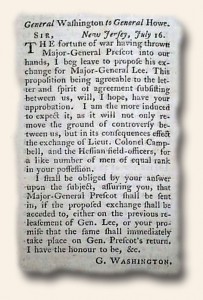
The “Gentleman’s Magazine” is a little gem packed with all the history one would want to find from the 18th century. Measuring about 5 by 8 inches and typically having about 40 pages they take up very little room in a collection. But best of all it is an accessible title, and at prices far below what would be found in comparable American & British newspapers of the same period.
There can be little excuse for holding back on buying the best events in American history if one is willing to add this famous & successful title to their collection. And there certainly will be a time when even this title will become very scarce as others discovery it as the little gem just begging to be collected.
Note: Rather than include an endless number of (annoying) links above, if you have interest in any of the topics discussed, simply go to the following link and enter the topic into the search field: www.RareNewspapers.com


